Cite this document
(“Japanese Great Armor Analysis Research Paper Example | Topics and Well Written Essays - 1750 words”, n.d.)
Retrieved from https://studentshare.org/history/1678854-japanese-great-armor-analysis
Retrieved from https://studentshare.org/history/1678854-japanese-great-armor-analysis
(Japanese Great Armor Analysis Research Paper Example | Topics and Well Written Essays - 1750 Words)
https://studentshare.org/history/1678854-japanese-great-armor-analysis.
https://studentshare.org/history/1678854-japanese-great-armor-analysis.
“Japanese Great Armor Analysis Research Paper Example | Topics and Well Written Essays - 1750 Words”, n.d. https://studentshare.org/history/1678854-japanese-great-armor-analysis.


